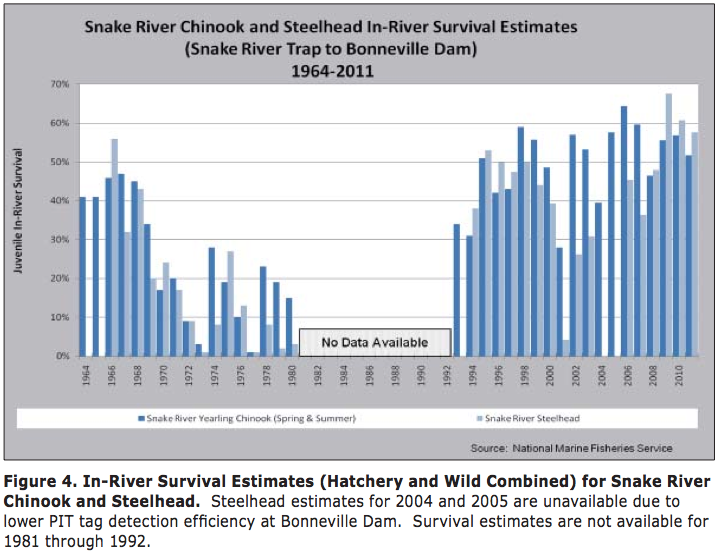forum
library
tutorial
contact

Environmentalists Refuse to See
Success of Salmon Efforts
by Terry Flores
Capital Press, June 26, 2014
|
the film forum library tutorial contact |

|
Environmentalists Refuse to See
by Terry Flores
|
 Salmon recovery efforts on the Columbia and Snake rivers are making well-documented progress.
Salmon recovery efforts on the Columbia and Snake rivers are making well-documented progress.
So-called fish conservation groups are blaming the Obama administration for "forcing" them into the courtroom. It's ironic. It's also not true.
Earth Justice, the National Wildlife Federation, Save Our Wild Salmon and various fishing groups are the ones ("plaintiffs") who have filed yet another legal challenge to the federal salmon plan. Last week they sued NOAA Fisheries, the agency responsible for ensuring protection of salmon and steelhead listed under the Endangered Species Act. It's deja vu all over again as they repeat claims they've made for years, despite documented progress that includes the most abundant salmon returns we've seen in decades.
The Endangered Species Act demands that federal hydropower dam operations do not jeopardize fish survival. The salmon plan that's now under fire meets this standard through the use of new fish-passage technologies and safe levels of spill (water spilled over the dams to help young fish moving downstream). In fact, NOAA Fisheries has shown that these methods are helping salmon survive at levels similar to those seen in rivers without any dams at all.
But this plan, vetted and endorsed by the Obama administration's top scientists, goes further. It puts salmon on the path to recovery with extensive habitat improvements that make this the most expensive effort to protect an endangered species in the nation. Proof of success is in historic fish returns over the last decade, including the return of over a million fall Chinook to the Columbia River last fall.
This year could be even better.
Columbia River coho and Columbia-Snake River fall chinook runs are both expected to be well over 1 million and, if so, would exceed previous counts since the dams were put in place. The Washington Department of Fish and Wildlife is even predicting that the wild fall chinook returns will exceed the hatchery returns for the first time since hatchery production began. The sockeye run is predicted to be the third largest on record, with previous records set in 2010 and 2012. Over 225,000 spring Chinook passed Bonneville Dam this year, the fifth highest count on record since at least 1980, and the summer Chinook run also is predicted to be above average.
These amazing salmon returns and predictions clearly tell us that our efforts are on the right track and bearing fruit, not futile or unsuccessful, as the anti-dam groups continue to claim. And, the public is talking. too: three out of four Northwest residents agree that it's critical for dams and salmon to co-exist, according to a March 2014 poll conducted for Northwest RiverPartners by DHM Research of Portland. By refusing to acknowledge that the hydro system is going beyond what even federal law demands to prevent harm and speed salmon restoration, the plaintiffs show they are out of touch not only with the law but with public sentiment.
These perennial critics also overlook the obvious: Dams are only one of many factors that determine the fate of salmon in the Columbia and Snake rivers. Most salmon mortality occurs in the ocean, making ocean conditions a much larger factor affecting their survival.
It's time to acknowledge that the hydro system -- and the Northwest families and businesses that pay for restoration efforts through their power bills -- are more than doing their part to protect these iconic fish.
Related Pages:
Enviro, Fishing Groups Say Latest BiOp Still Flawed by Bill Rudolph, NW Fishletter, 6/26/14
Making History in Fall Chinook Salmon Protection by Terry Flores, Capital Press, 10 /11/13
Support Balance Between Fish and Economy by Terry Flores, The News Tribune, 10/3/13
Oregon Should Join the Collaboration to Save Salmon by Scott Corwin & Terry Flores, The Oregonian, 9/29/12
Reaction to Judge Redden's pro-Breach Comments (including Terry Flores) by Eric Barker, Lewiston Tribune, 4/26/12
Salmon Protection Plan isn't Broken, So Stop Trying so Hard to 'Fix' It by Terry Flores, Idaho Statesman, 8/28/11
Federal Salmon Plan Stands Strong by Terry Flores, Sustainable Business Oregon, 12/12/11
Arguments for Removal of Snake River Dams are Laughable, Absurd by Terry Flores, Seattle Times, 8/23/11
Snake River is a Model of Environmental & Economic Sustainability by Terry Flores, The Oregonian, 1/27/11
learn more on topics covered in the film
see the video
read the script
learn the songs
discussion forum
